Today’s Gazette reports on the Conservation Commission and Planning Board hearings yesterday for Kohl Construction’s proposed condo project off North Street (see schematic diagrams and narrative). We’ll have videos of both these hearings online within a few days. No decisions were made. Hearings are scheduled to continue on February 26 (Conservation Commission) and March 26 (Planning Board). The Gazette writes:
The Planning Board has yet to render a decision regarding a 25-unit townhouse proposal in the North Street neighborhood, but its members heard an earful of opposition to the project during a lengthy public hearing Thursday night…
The North Street Condominiums project…drew the most attention, first at the Conservation Commission and later at the Planning Board. Both boards did not make any decisions…
The townhouse project calls for six buildings of attached condos to be constructed on a 5.6-acre wooded area off North Street and south of Northern Avenue. The site includes 2.2 acres of wetlands…
Residents voiced many concerns about what Kohl’s project might do to the neighborhood, with traffic, water run-off and flooding, and housing density coming up most often. Others expressed concern about tree-clearing and having a development that doesn’t fit in with the character of the neighborhood…
At the Conservation Commission hearing, Land Use and Conservation Planner Bruce Young mentioned that he finds many properties around Northampton are out of compliance with wetlands protection agreements. Enforcement is a tedious process that is consuming a large amount of his time. People are disregarding no-disturb boundaries, mowing where they shouldn’t mow, etc. This is entirely consistent with scientific findings that wetlands buffers of less than 50 feet are generally ineffective at protecting wetlands. The answer, as one Conservation Commissioner put it, is “space”.
Here is the area Kohl proposes to build in, followed by pictures of the proposal as presented yesterday. A concern is that the paucity of yardspace and high density of housing units would lead residents to “push out”, eating into the remaining wetland buffers and perhaps the wetland itself (mowing beyond promised boundaries, storing items there, dumping yard waste, etc.). Another concern is that the stormwater basins would pose a safety hazard to children. Bear in mind that the satellite photo understates the number of mature trees that would be cut down, as trees must be felled not just to make way for the units but also for the roads and stormwater basins. Still more trees might be put at risk from heavy construction equipment rolling over their roots, soil compaction, and increased exposure to wind due to the loss of trees around them.
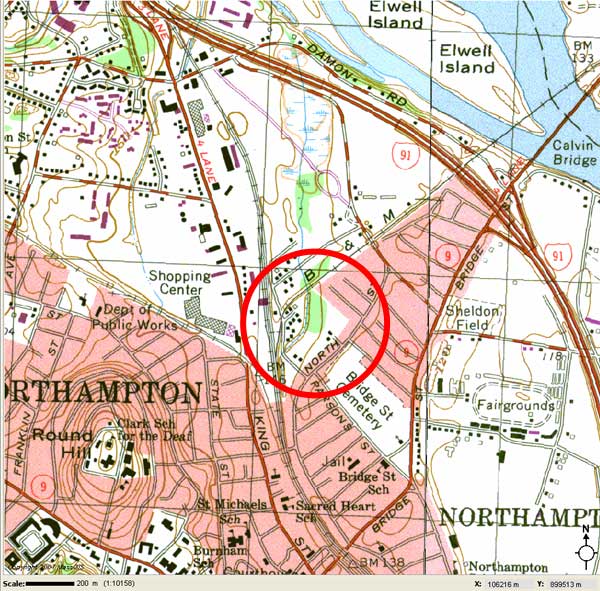
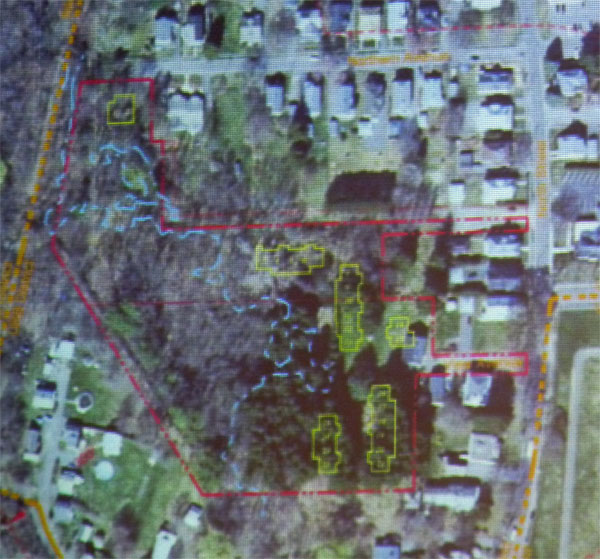
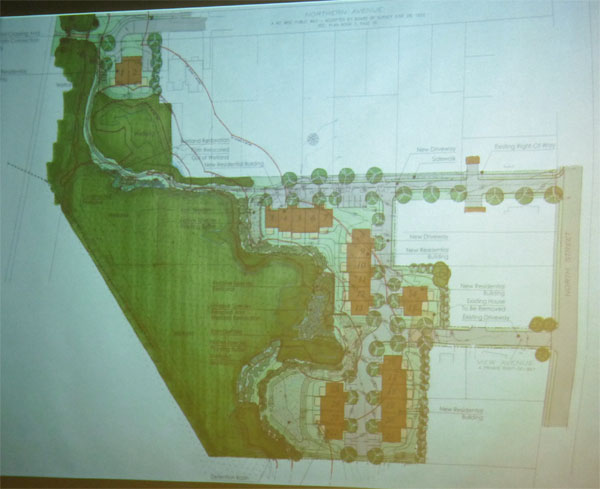
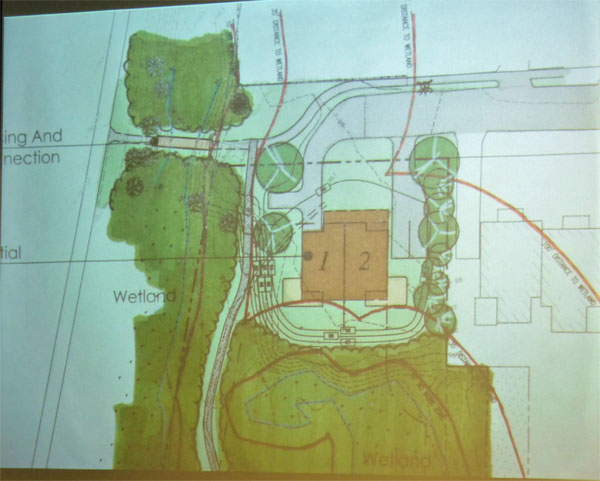
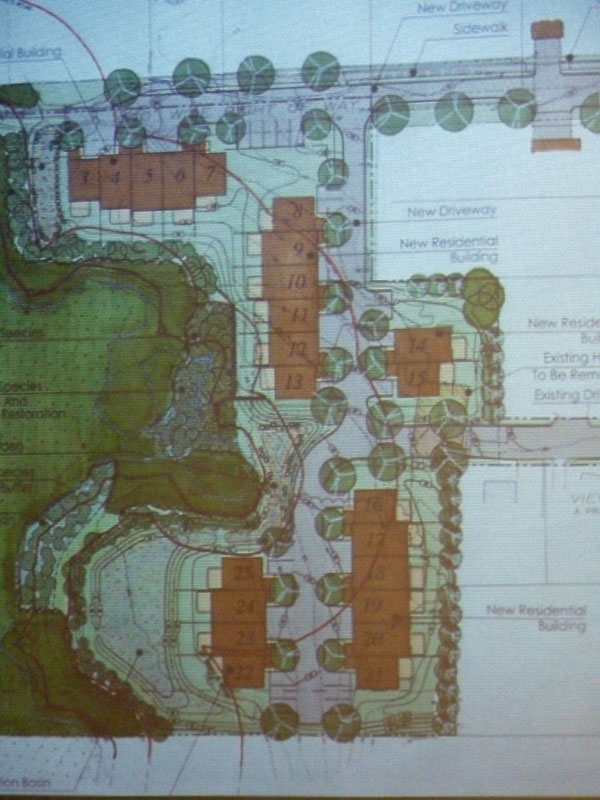
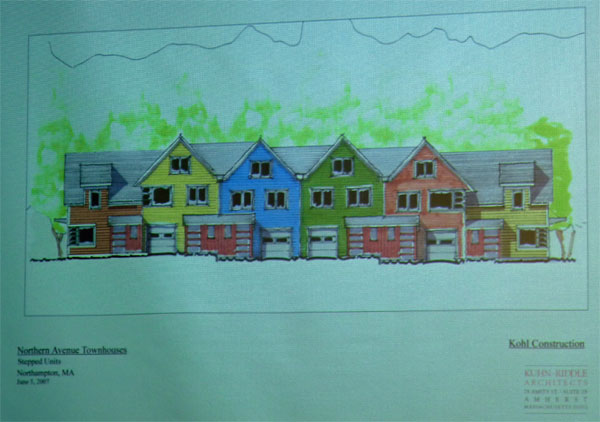
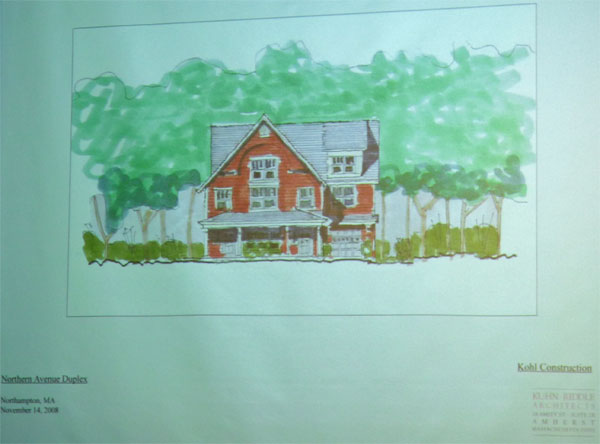
Here is the Staff Report to Conservation Commission prepared by Bruce Young:
…6:30 PM
Continuation of a Notice of Intent filed by Tofino Associates, Inc. and Northern Avenue Homes, Inc. for the construction of twenty-five dwelling units and associated roadways, parking areas, driveways, sidewalks, utilities, landscaping and stormwater management system. Project is proposed to take place in the 100-foot buffer zone of Bordering Vegetated Wetlands. Project location is Northern Avenue, Map Id 25C-12 and 25C-17.
Staff Recommendation:
The project can be permitted but, the Commission should continue the hearing until the applicant provides updated stormwater calculations that are acceptable by the Commission and the Department of Public Works, or issue an Order of Conditions with a condition that, if the Department of Public Works determines that the stormwater system needs to be modified, the applicant shall not create any additional disturbance area beyond the 35’ No-Disturb Line. Additionally, the Commission, assuming that the Planning Board may modify the plan, might want to add a condition that allows minor modifications to the site plan in the area between the 35’ No-Disturb area and the 100’ buffer zone, as long as the impervious surface areas are not relocated closer to the wetlands, and there is not net increase in the total amount of impervious surface within that area.
Other possible conditions:
-General Conditions #1-32-Minimum 4’ diameter boulders spaced 2’ apart along the entire Limit of Disturbance Line
-Covenant-snow shall not be stored in wetlands, buffer zones or stormwater control areas
– 4’ Concrete or granite bollards shall be placed every 3’ along areas where wetlands or stormwater controls are adjacent to streets or sidewalks
-Covenant-Road salt or lawn chemicals shall not be used on any property. An annual signoff of this requirement by the homeowners association shall be provided to the Conservation Commission by October 1st
-Covenant-Annual inspection report of the No-Disturb Area shall be submitted to the Conservation Commission by October 1st
-Applicant provides a five-year invasive removal plan for entire site. Funding or a covenant requiring funding by the Homeowners Association shall be required to implement the plan. Annual reports on the invasive removal project shall be submitted to the Conservation Commission by October 1st
-Applicant replaces the proposed rip-rap outlet structures with a material that provides enhanced habitat value
-Lawn areas shall not be allowed beyond the 35’ No-Disturb line
-All sidewalks and bikepaths shall be constructed of pervious pavers or pervious pavement
-Above ground cisterns and rainbarrels could be used to catch and store some of the roof runoff.
-Street sweeping shall be conducted four times per year.
Here is an analysis of Kohl’s proposal prepared by Dr. Bryan S. Windmiller of HYLA Ecological Services for the North Street Neighborhood Association:
I have prepared the following brief commentary on the Notice of Intent for construction of the North Street Condominiums development, proposed by Tofino Associates along North Street in Northampton, Massachusetts. I submit these comments to you with the intention that they be distributed to the Northampton Conservation Commission and included in the record of commentary of the Notice of Intent. My comments pertain to the latest revised plans for the project (Berkshire Design Group, Inc., Jan. 16, 2009).
I contend that the extensive buffer zone alterations proposed by Tofino Associates to a largely forested buffer zone adjacent to the Bordering Vegetated Wetlands along Millyard Brook, will inevitably result in the physical, chemical, and biological alteration of these wetlands. The proponent desires to work very close to the edge of wetlands, with intrusions apparently as close as 12 feet from the wetland edge. Cumulatively, by the proponents reckoning, the construction would directly alter 6,325 sq. ft. of buffer zone between 35 and 10 feet from the wetland edge. The project would result in the destruction of the great majority of natural vegetation, most of currently mature woods.
Furthermore, in an effort to meet the stringent conditions set under the newly revised Northampton Wetlands Protection Ordinance regarding any proposal to alter buffer zone within 35 feet of a wetland resource area, Tofino Associates proposes to disturb an additional several thousand square feet of buffer zone between 10 and 35 feet from the wetlands in the course of creating tiny “wetland replication” areas. Further, the proponent wants to directly disturb a significant area of forested bordering vegetated wetland through an “invasive species removal and native plantings” scheme. These actions are presumably meant to be “extraordinary” mitigation to compensate for the unprecedented buffer zone intrusions that are proposed. I argue here that this logic is ecologically fallacious: the applicant proposes to mitigate the impacts of buffer zone disturbance by disturbing even more area of inner buffer zone and forested wetland itself. This mitigation effort will, in fact, only worsen the impacts to the wetlands bordering Millyard Brook.
1. The Proposed Buffer Zone Alterations Will Inevitably Alter the Adjacent Wetland Resource Areas in Many Ways
The Massachusetts Wetland Protection Act seeks to prevent alterations to wetland resource areas within the Commonwealth. In doing so, the regulations use a very stringent definition of the word “alter” (310 CMR 10.04):
Alter means to change the condition of any Area Subject to Protection Under M.G.L. c. 131,
§ 40. Examples of alterations include, but are not limited to, the following:
(a) the changing of pre-existing drainage characteristics, flushing characteristics, salinity distribution, sedimentation patterns, flow patterns and flood retention areas;
(b) the lowering of the water level or water table;
(c) the destruction of vegetation;
(d) the changing of water temperature, biochemical oxygen demand (BOD), and other physical, biological or chemical characteristics of the receiving water.
The idea that the applicant can cut down mature woods to within 12 feet of the wetland edge and have no effect on the physical, chemical, and biological characteristics of wetlands a mere long-jump away is completely untenable. There is an abundance of scientific evidence demonstrating that the effects of removing natural vegetation, particularly forest cover, extend far into the remaining woodland from the newly-created edge. The following is a sampling of known “edge effects” that alter ecological communities much beyond 12-feet from a disturbed area (e.g. an area of construction activities).
Altered Physical Conditions: The shade of a closed-canopy forest produces very different physical conditions at ground level than experienced in adjacent open areas. Open areas are windier and drier at ground level, have sharper temperature fluctuations, and much deeper frost lines than adjacent woods. Rain strikes the ground with greater erosive force in open areas. These differences do not end abruptly at the forest edge but are propagated well into the woods. Light levels near a forest edge return to normal (i.e. similar to forest interior) in only a few meters from the edge (e.g. <20 feet), but wind patterns, turbulence, and reduced humidity typically extend from 0.5 to several times the average height of canopy trees (e.g. >>30 feet into the North Street Woods, Richard T.T. Forman, Land Mosaics, 1995. Pp. 88-89). These altered physical conditions increase the penetration of invasive plant seeds into the forest, and stress forest interior adapted native forest floor plants.
Increased Tree Mortality Near the New Forest Edge: Changes in wind speed and turbulence near a newly-created forest edge increase the likelihood of tree mortality at some distance from the edge. Wind-throw of trees becomes more common, with effects continuing many yards into the adjacent forest. Quoting from an ecology textbook (R.J. Whittaker and J.M. Fernandez-Palacios. Island Biogeography, Ecology, Evolution, and Conservation. 2001. P. 208):
“We can say, however, that at the edge of a newly-fragmented woodland patch, increased desiccation, wind-damage (to trees), and tree-throw can each be significant… Wind-throw of dominant trees can result in changes in the vegetation structure, and allow recruitment of earlier succesional species (e.g. many invasive weedy species).” (Italics are mine.)
In addition, the construction process itself is likely to damage trees near the new forest edge as roots are dug up and the soil around them compacted by machinery. In the proposed Tofino Associates development, the roots of the mature trees are likely to extend 25 feet or more from the trunks of the trees. Trees may thus be readily damaged or killed by construction even though their trunks are yards away. If these damaged trees fall, they propagate changes in the woods (light-levels, humidity, penetration by weedy seeds, etc.) further still into the adjacent wetlands.
Increased Concentrations of Salt: Large quantities of salt are applied to roads, driveways, and stairs and walkways around buildings in Massachusetts (17.6 tons per lane-kilometer of Mass. roadways – this and all references in this section from: N.E. Karraker. “Impacts of road deicing salts on amphibians and their habitats”. Urban Herpetology. 2008. Pp. 211-223.) Salt is extremely soluble in water and is not extracted in any conventional stormwater treatment systems. The result is an inevitable increase in the salinity in wetlands and water bodies near newly created roadways and houses. Changes in salinity are specifically regarded as an alteration under the Massachusetts Wetlands Protection Act (310. CMR 10.04, see definition above). I have measured the conductivity (an indirect measurement of salinity) of vernal pools and other wetlands in approximately 60 areas of Westford, Massachusetts and found evidence of severe salt pollution in pools many yards from homes and roadways. Karraker (Ibid) reports studies noting that most salt impacts occur within 70-100 feet of roads.
The ecological consequences of increased salinity have received some degree of study and are summarized in Karraker (Ibid). In areas with significant de-icing salt impacts, plant species diversity has been shown to decrease, the abundance of non-native
invasives, particularly purple loosestrife (Lytrhum salicaria) and Phragmites (Phragmites australis) has been shown to increase, and the salt negatively impacted aquatic invertebrates and the survival of frog and salamander eggs.Increased Levels of Other Pollutants: People apply numerous toxic substances to their lawns, sheds, and home exteriors. Some of these substances are water soluble and readily transported into adjacent wetlands by runoff or via infiltration into groundwater and then groundwater discharge into wetlands at low seasonal water levels. Other substances are readily adsorbed onto dust particles. Dust is to be found in abundance around newly disturbed house sites and the dust is blown many yards into nearby woodlands on the altered wind currents near the forest edge. As a result, wetlands located in close proximity to residential areas and with little intervening natural vegetated buffer are prone to elevated levels of contamination, regardless of the effectiveness of stormwater detention systems.
Increased Abundance of Invasive Exotic Plant Species: One of the most insidious edge effects that propagate into surrounding wetlands and woodlands from residential edges is the increased abundance of many invasive exotic species. I have already alluded to how changes in wind patterns, soil disturbance following construction, and the mortality of trees near newly-created forest edges facilitates invasion by exotic plant species. R. Watkins et al. (“Effects of forest roads on understory plants in a managed hardwood landscape”. Conservation Biology 17(2): 411-419. 2003) report findings that: “Exotic species were most prevalent within 15 m (50 feet) of roads, occurring infrequently in the interior forest.” Allowing the proponent to build within 15 feet of the edge of the Millyard Brook wetlands will greatly encourage further invasion of this area by exotic plant species.
Population Decreases in Wetland-Dependent Wildlife: Although a wetland as defined by law may end abruptly at a delineated boundary, this is not the case for the extent of wetland-wildlife habitat. Many wetland-dependent species depend directly on surrounding upland habitats for their life cycles. Their populations may thus be destroyed by work in buffer zones and adjacent uplands even if the adjacent wetland is left intact. Windmiller et al., for example, documented the extirpation of a wood frog (Rana sylvatica) population and the decline of populations of three species of vernal pool-dependent amphibians after adjacent uplands were cleared for residential construction (“Breeding amphibian population declines following loss of upland forest habitat around vernal pools in Massachusetts.” Urban Herpetology 41-52. 2008.). Such effects can extend far beyond the edge of the delineated wetlands.
2. Allowing the Alteration of Additional Buffer Zone and Wetland Resource Areas Will Worsen the Effects of the Development – Not Improve the Wetland Resource AreaThe Northampton Wetlands Protection Ordinance requires a strict condition of projects seeking to encroach closer than 50-foot from a wetland edge, permitting such encroachment only “where development includes mitigation that will improve the existing condition of the wetlands or adjacent upland area…”. In permitted zoning districts, further encroachment closer than 35 feet from the wetland edge requires “extraordinary mitigation, replication, restoration, or open space preservation measures”. In an effort to meet these strict standards, Tofino Associates proposes creating several small “wetland replication areas” and additionally removing “invasive species” and planting native ones in a ca. 3,800 sq. ft. area that intrudes into the wetland itself.
This additional removal of forested buffer zone will only worsen the impacts upon the adjacent wetlands in all the ways described above. Even more trees will be removed and the cleared edge will be placed either at the very wetland edge or, indeed well into the wetland interior. Thus, further alterations of the chemical, physical, and biological characteristics of the Millyard Brook wetlands will occur deep into the wetlands themselves.
Furthermore, the small, very narrow “wetland replication” areas will be of extremely dubious ecological value. They will do little or no good, other than allowing the proponent to claim that he has increased the area of wetlands. The tiny replication areas will be entirely “edge” habitat in an ecological sense, and certainly subject to intense colonization by exotic species. Wetland replication areas are notorious for failing to replicate existing wetland functions in any meaningful way. As Stephen Meyer, former M.I.T. professor and chair of the Sudbury, MA Conservation Commission wrote:
“A recent study suggests that fewer than half of all constructed wetlands actually function as wetlands, and that few if any attain the full functionality of the original natural wetland (NAS, 2001).” (S. Meyer. and D. Konisky. “Community-based environmental protection: A status report and some new evidence”. 2005. See: http://web.mit.edu/polisci/research/meyer/Outcomes_April05.pdf)
The chances for ecological failure of very small replication areas (<2,000 sq. ft.) are particularly high given the nature of ecological edge effects.
Finally, the intended removal of Norway spruce (Picea abies), a non-native species occurring in a dense mature stand in the Millyard Brook wetlands can, in no way be construed as an improvement. Although these trees are not native, they provide complex habitat structure for wildlife, help bind the soil that enhances the erosion control and pollution attenuation functions of the wetlands, and moderate climate and humidity levels in the wetlands. The removal of these trees will cause major direct impacts to the wetlands and adjacent buffer zone and will greatly facilitate the establishment of truly invasive exotic species. The tree removal will also greatly reduce and simplify existing wildlife habitat. The resident birds, mammals, and invertebrates care not one whit that these mature trees are originally native to Europe; they exist and provide excellent habitat structure.
The intended use of herbicides by the applicant to control Japanese knotweed (Polygonum cuspidatum) will moreover result in the pollution of the wetland with herbicides and their toxic surfactant agents. The commonly used herbicide glyphosate (Rodeo and Roundup) has been shown to be highly toxic to amphibians, for example, in numerous papers by Rick Relyea and colleagues (see summary at: http://www.medicalnewstoday.com/articles/22159.php). Japanese knotweed and multiflora rose (Rosa multiflora) are furthermore difficult to eradicate, even with herbicides. To do so will require significant doses of herbicide applied many times.
In the end, such schemes are likely only to result in further degradation of the wetland system. How long will the applicant continue to remove exotic species and replace dead shrubs and trees that are planted in the mitigation areas? Three years? Five? Ten? A single generation for native forest trees lasts decades. In such a time scale, any such heroic efforts will certainly have been abandoned and the seed bank of invasive species in the soil will still be healthy. The Millyard Brook wetland will have been reduced
and degraded physically, chemically, and biologically by the construction of the proposed development. Deed restrictions and the exact location of no-build boundaries will have been long forgotten and yard waste, trash, and additional clearings will have extended into the wetlands and beyond the edge of the nearby lawns. This effect will be exacerbated by the minimal outdoor space provided for residential development of such high density.Sadly, the citizens of Northampton will have lost a large chunk of increasingly rare urban greenspace in the name of “Smart Growth”.
I hope that these comments prove useful. I can assist you, if needed, in gathering additional reference sources to support the arguments made here.
Sincerely,
Bryan Windmiller, Ph.D.
Wildlife and Wetland Ecologist
See also:
Our Ad in Today’s Gazette: A Review of Our Objections to the Kohl Condo Proposal
Smart Growth vs. “Smart Growth”
Smart Growth, in its full flower, contains numerous protections,
safeguards, checks and balances. The Urban Land Institute includes the
following among its Ten Principles for Smart Growth on the Suburban Fringe (PDF):
Identify and Sustain Green Infrastructure
…Green
infrastructure networks encompass a wide range of landscape elements,
including natural areas such as wetlands, woodlands, waterways, and
habitat; public and private conservation lands such as nature
preserves, wildlife corridors, greenways, and parks; and public and
private working lands of conservation value such as forests, farms, and
ranches. It also incorporates outdoor recreation and trail networks as
well as cultural and historic resources that provide the community its
character.When we use the word infrastructure, we usually think
of built infrastructure such as roads, electric power lines, and water
systems and social infrastructure such as schools, hospitals, and
libraries. The concept of green infrastructure, however, elevates air,
land, and water to an equal footing with built infrastructure and
transforms open space from “nice to have” to “must have.” At the same
time, green infrastructure helps provide a framework for growth by
identifying the places that should not be built on, putting a stop to
the project-by-project battles that developers face over open space and
the environment…Some argue that land in America is still
plentiful, but the fact that vast tracts of land might be available
thousands of miles away matters little to the dwellers of today’s
growing metropolises. With the concentration in coastal areas—53
percent of the population on 17 percent of our nation’s land area—the
real challenge is finding open space reasonably close to jobs and
housing…When planned as part of a system of green
infrastructure, open space can meet a community’s need for parkland and
outdoor recreation space while also helping to shape urban form and
buffer incompatible uses. Green infrastructure can even reduce public
costs for stormwater management, flood control, and other forms of
built infrastructure…Protect Environmental Systems and Conserve Resources
Communities
on the fringe are typically in a better position to protect and
conserve natural systems that perform important functions like water
filtration and storage, flood control, and maintenance of clean air
than more urbanized areas… Unfortunately, fringe communities
undergoing rapid development are often understaffed or ill equipped to
deal with the consequences of rapid growth. Consequently, they
frequently make numerous, poorly informed decisions on a site-by-site
basis that end up degrading natural systems in the process of land
development…Minimal disturbance makes it easier to use
natural drainage for stormwater management and native vegetation for
landscaping, and to incorporate existing habitat into the community.
Less disturbance means less grading and possibly lower infrastructure
costs…Provide Diverse Housing Types and Opportunities
If
growth on the fringe is going to be “smart,” it will be necessary to
provide more housing choices to appeal to various market segments and
demographic groups in the population. Of critical importance to the
success of smart growth on the fringe is a mix of housing types, price
points, and uses offering a more vital and diverse community.The
need to direct growth to walkable mixed-use neighborhoods rather than
to conventional subdivisions offers the opportunity for more diverse
housing types. Rental and ownership single-family houses with yards,
townhouses, and multifamily apartment buildings are all needed to meet
the varied lifestyles of people living in the suburbs……a mix of housing opportunities helps to create a sustainable community, not just a one-generation subdivision.
Preserve the Community’s Character
…as
Mark Twain once said, “We take stock of a city like we take stock of a
man. The clothes or appearance are the externals by which we judge.”
Although the community’s character is also important, its appearance
creates the first impression, and much development on the fringe is
unattractive and bears little relationship to a community’s history,
culture, or geography. Just look around: billboards, cluttered
commercial strips, and look-alike subdivisions are all too common
across America.The relationship between a community’s character
and its economic well-being is immense but too often ignored.
Attractive, well-planned communities always attract more visitors and
high-quality investment than ugly ones. Unfortunately, current zoning
standards and regulations do little to address visual quality,
community character, or urban design. As a result, many communities are
slowly losing their sense of place…According to Jim
Constantine, a market specialist who does “curb appeal” surveys for
developers, “Consumers are turned off by cookie-cutter subdivisions and
the homogenous look of houses.” Increasingly, buyers are attracted to
vernacular and historical house styles that characterize their
immediate area or region.
Staunch New Urbanist Laurence Aurbach offers additional principles on his website. Here he quotes with approval Oscar Newman, proponent of the “defensible space” concept:
“[Newman]
criticized residential buildings that were turned away from the street,
with parking lots in front. He recommended sidewalks and on-street
parking…”
Alas, developers often seize on convenient aspects of Smart Growth that
align with their profit goals and disregard others. A common result
appears to be overlarge developments, inapt developments, and/or
excessive density. These are major bones of contention in Los Angeles and Berkeley, to give two examples…
The problems with Kohl’s condo proposal include:
* It threatens green infrastructure by putting roads and structures as close as 35 feet or less to a wetland. Scientific evidence
indicates that substantial disturbance within 50 feet puts wetland
ecology at risk and threatens water quality. In addition, the condos
themselves appear to be at risk of flooding.
* It goes against the existing character and diversity of housing stock in the neighborhood by offering a monotonous, cookie-cutter design scheme with little sense of place.
* As Daryl LaFleur
observes, “the Kohl North Street area development proposal includes row
house condominiums set to the rear of parking lots, not free standing
detached single family homes that front the ‘street’, which would
better match the existing neighborhood and is also a tenet of Smart
Growth.”
Smart Growth is most palatable when it’s
implemented as a whole. When public and private actors are allowed to
cherry pick aspects that suit their convenience, the “Smart” can be
lost.
Boston Globe: “How the city hurts your brain” (1/2/09)
Natural settings are full of objects that automatically capture our
attention, yet without triggering a negative emotional response —
unlike, say, a backfiring car. The mental machinery that directs
attention can relax deeply, replenishing itself…
While people have searched high and low for ways to improve cognitive
performance, from doping themselves with Red Bull to redesigning the
layout of offices, it appears that few of these treatments are as
effective as simply taking a walk in a natural place…